
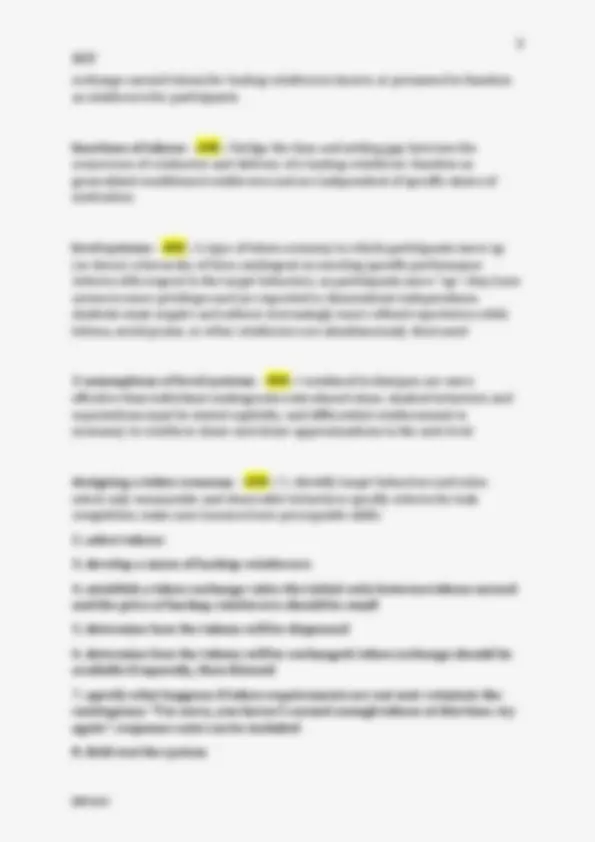
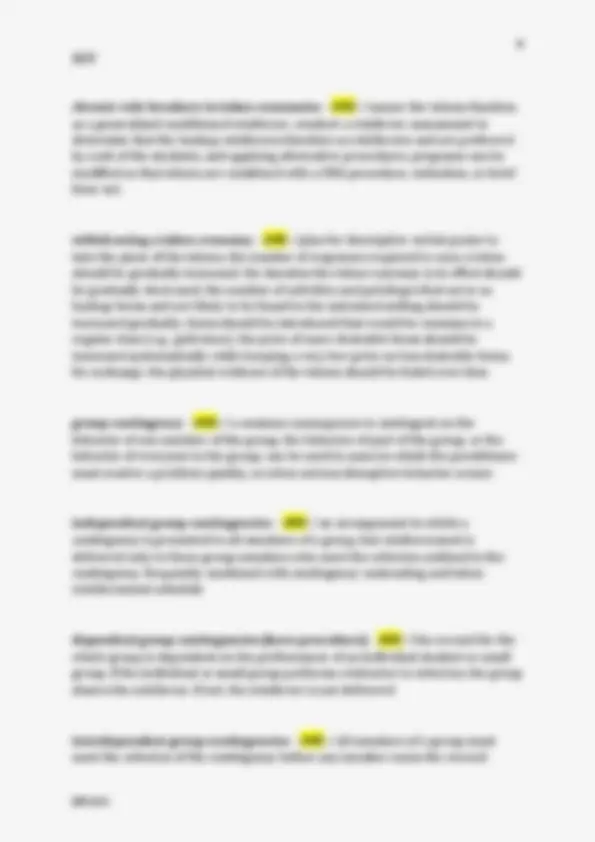
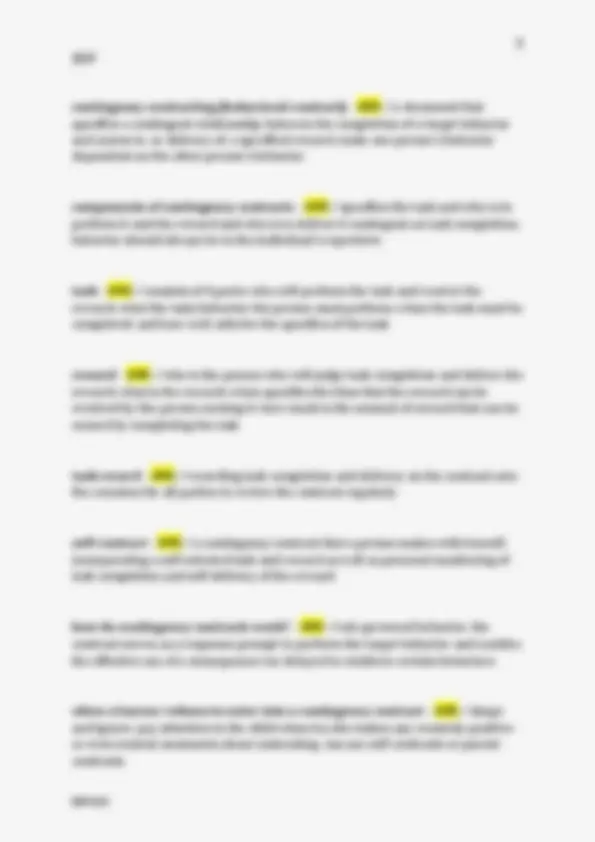
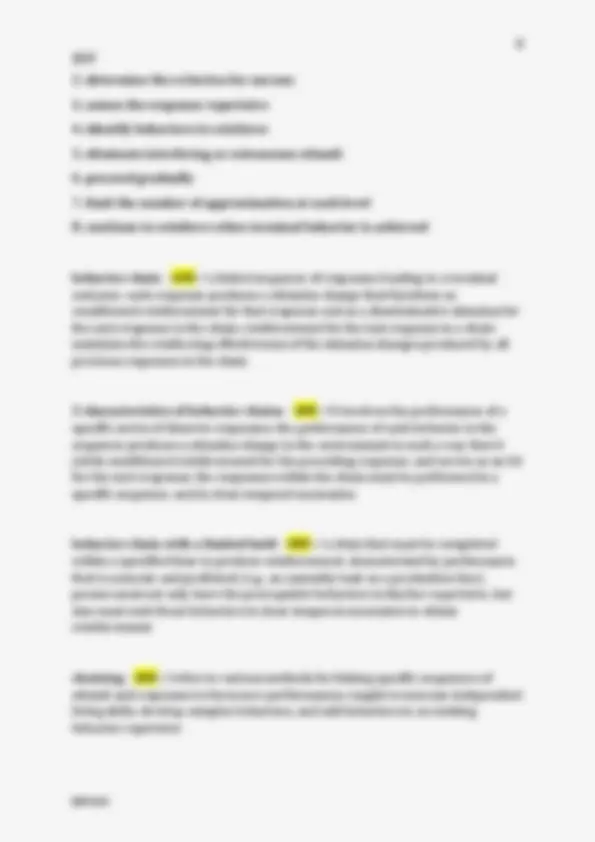
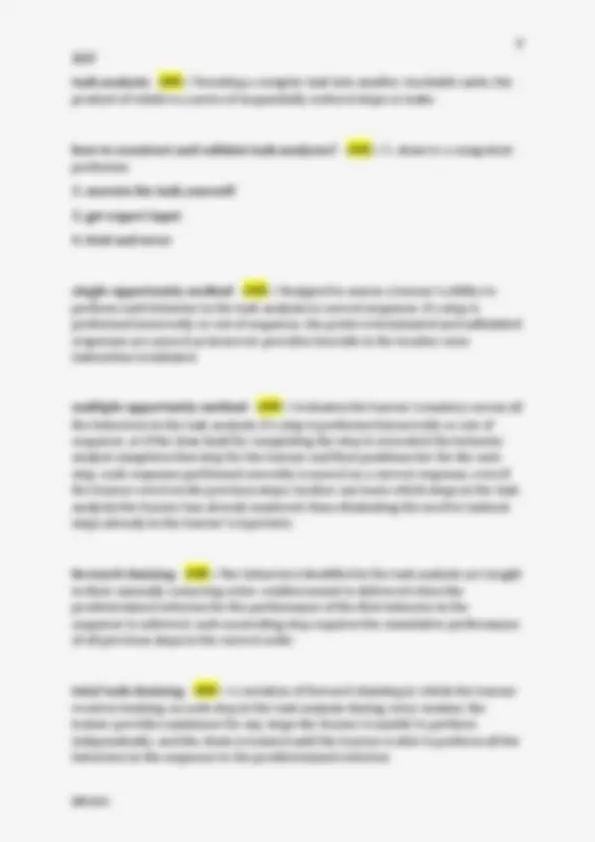
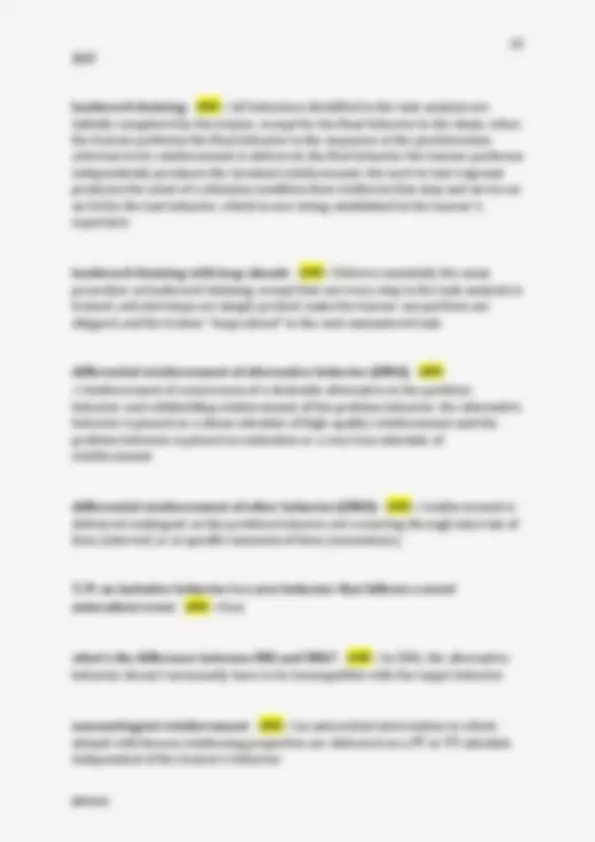


Study with the several resources on Docsity

Earn points by helping other students or get them with a premium plan


Prepare for your exams
Study with the several resources on Docsity

Earn points to download
Earn points by helping other students or get them with a premium plan
Community
Ask the community for help and clear up your study doubts
Discover the best universities in your country according to Docsity users
Free resources
Download our free guides on studying techniques, anxiety management strategies, and thesis advice from Docsity tutors
A comprehensive set of questions and answers for edf 6223 exam 2, covering key concepts in behavior analysis, including functional communication training (fct), token economies, and contingency contracts. It delves into the principles, applications, and practical considerations of these behavioral interventions, offering insights into their effectiveness in managing challenging behaviors and promoting positive change.
Typology: Exams
1 / 11

This page cannot be seen from the preview
Don't miss anything!







guidelines for using the high-p sequence - ANS ✓compliance with high-p instructions should be 80% or greater; with low-p, 50% or less; don't use the high-p request sequence after an occurrence with problem behavior; present the high-p requests at the beginning and throughout the instructional period to reduce the possibility of problem behaviors producing reinforcement; present high-p instructions rapidly, with brief intervals what should the ratio of high-p to low-p instructions be when fading the intervention? - ANS ✓ 1 - to- 1 functional communication training - ANS ✓establishes an appropriate communicative behavior to compete with the problem behaviors evoked by a MO. develops communicative behaviors that are sensitive to existing MOs. DRA is used to teach an adaptive response that is functionally equivalent to the problem behavior FCT is an effective treatment for many problem behaviors maintained by ___ ___ - ANS ✓social attention effective use of FCT - ANS ✓dense schedule of reinforcement; decreased use of verbal prompts; behavior reduction procedures why is thinning the FCT reinforcement schedule with constant time increases, proportional time increases, or session-to-session time increases ineffective? - ANS ✓they are incompatible with the methods used to
differentially reinforce the alternative communicative behavior because the FCT intervention doesn't alter the MO that evokes the problem behavior how do you thin an FCT schedule? - ANS ✓once the communicative response is established, gradually thin the FI schedule. use clocks or picture cues to announce when reinforcement is available advantages of FCT - ANS ✓excellent chance for generalization and maintenance of the alternative communicative response because the communicative response often functions to recruit reinforcement from significant others; may have high social validity disadvantages of FCT - ANS ✓treatment packages usually include extinction, which may produce undesirable effects; participants may emit inappropriately high rates of the alternative communicative response; recruitments of reinforcement can occur at inconvenient or impossible times for the caregiver much of the misbehavior in children can be viewed as a form of - ANS ✓communication what is the mechanism of behavior change that underlies the reduction of problem behavior using FCT? - ANS ✓functional equivalence what concept is central to the success of FCT? - ANS ✓recruiting natural contingencies of reinforcement 3 major components of token economies - ANS ✓a list of target behaviors; tokens, points, or marks participants earn for emitting the target behavior; and a menu of backup reinforcers that participants obtain by exchanging earned tokens how do token economies work? - ANS ✓the behaviors to be reinforced are identified and defined --> a medium exchange (token) is selected --> participants
chronic rule breakers in token economies - ANS ✓ensure the tokens function as a generalized conditioned reinforcer, conduct a reinforcer assessment to determine that the backup reinforcers function as reinforcers and are preferred by each of the students, and applying alternative procedures. programs can be modified so that tokens are combined with a DRA procedure, extinction, or brief time-out withdrawing a token economy - ANS ✓plan for descriptive verbal praise to take the place of the tokens. the number of responses required to earn a token should be gradually increased. the duration the token economy is in effect should be gradually decreased. the number of activities and privileges that serve as backup items and are likely to be found in the untrained setting should be increased gradually. items should be introduced that would be common in a regular class (e.g., gold stars). the price of more desirable items should be increased systematically while keeping a very low price on less desirable items for exchange. the physical evidence of the tokens should be faded over time group contingency - ANS ✓a common consequence is contingent on the behavior of one member of the group, the behavior of part of the group, or the behavior of everyone in the group. can be used in cases in which the practitioner must resolve a problem quickly, as when serious disruptive behavior occurs independent group contingencies - ANS ✓an arrangement in which a contingency is presented to all members of a group, but reinforcement is delivered only to those group members who meet the criterion outlined in the contingency. frequently combined with contingency contracting and token reinforcement schedule dependent group contingencies (hero procedure) - ANS ✓the reward for the whole group is dependent on the performance of an individual student or small group. if the individual or small group performs a behavior to criterion, the group shares the reinforcer. if not, the reinforcer is not delivered interdependent group contingencies - ANS ✓all members of a group must meet the criterion of the contingency before any member earns the reward
contingency contracting (behavioral contract) - ANS ✓a document that specifies a contingent relationship between the completion of a target behavior and access to, or delivery of, a specified reward. make one person's behavior dependent on the other person's behavior components of contingency contracts - ANS ✓specifies the task and who is to perform it and the reward and who is to deliver it contingent on task completion. behavior should always be in the individual's repertoire task - ANS ✓consists of 4 parts: who will perform the task and receive the reward; what the task/behavior the person must perform; when the task must be completed; and how well calls for the specifics of the task reward - ANS ✓who is the person who will judge task completion and deliver the reward; what is the reward; when specifies the time that the reward can be received by the person earning it; how much is the amount of reward that can be earned by completing the task task record - ANS ✓recording task completion and delivery on the contract sets the occasion for all parties to review the contract regularly self-contract - ANS ✓a contingency contract that a person makes with herself, incorporating a self-selected task and reward as well as personal monitoring of task completion and self-delivery of the reward how do contingency contracts work? - ANS ✓rule governed behavior. the contract serves as a response prompt to perform the target behavior and enables the effective use of a consequence too delayed to reinforce certain behaviors when a learner refuses to enter into a contingency contract - ANS ✓shape and ignore. pay attention to the child when he/she makes any remotely positive or even neutral comments about contracting. can use self-contracts or parent- contracts
what is the most important property defining imitation? - ANS ✓the controlling relation between a model's demonstration and a learner's performance of topographically similar behavior T/F: an imitative behavior is a new behavior that follows a novel antecedent eventT/F: an imitative behavior is a new behavior that follows a novel antecedent event - ANS ✓true modeling - ANS ✓a behavior change strategy in which learners acquire new skills by imitating demonstrations of the skills by live or symbolic models. the model shows, demonstrates, or conveys exactly the behavior the learner is expected to convey. can be live, symbolic, or recorded shaping - ANS ✓the differential reinforcement of successive approximations toward a terminal behavior. the antecedent stimulus for the terminal behavior stays the same, while the response progressively becomes more differentiated differential reinforcement - ANS ✓presenting an unconditioned or conditioned reinforcer only to those emitted members of a response class that share a specified dimension or quality, while placing all other emitted response class members on extinction performance dimensions that can be shaped - ANS ✓1. topography: refining motor movements
**2. rate: increasing number of correct responses
**2. determine the criterion for success
backward chaining - ANS ✓all behaviors identified in the task analysis are initially completed by the trainer, except for the final behavior in the chain. when the learner performs the final behavior in the sequence at the predetermine criterion level, reinforcement is delivered. the first behavior the learner performs independently produces the terminal reinforcement. the next-to-last response produces the onset of a stimulus condition that reinforces that step and serves as an Sd for the last behavior, which is now being established in the learner's repertoire backward chaining with leap aheads - ANS ✓follows essentially the same procedure as backward chaining, except that not every step in the task analysis is trained. selected steps are simply probed. tasks the learner can perform are skipped, and the trainer "leaps ahead" to the next unmastered task differential reinforcement of alternative behavior (DRA) - ANS ✓reinforcement of occurrences of a desirable alternative to the problem behavior and withholding reinforcement of the problem behavior. the alternative behavior is placed on a dense schedule of high-quality reinforcement and the problem behavior is placed on extinction or a very lean schedule of reinforcement differential reinforcement of other behavior (DRO) - ANS ✓reinforcement is delivered contingent on the problem behavior not occurring through intervals of time (interval) or at specific moments of time (momentary) T/F: an imitative behavior is a new behavior that follows a novel antecedent event - ANS ✓true what's the difference between DRI and DRA? - ANS ✓in DRA, the alternative behavior doesn't necessarily have to be incompatible with the target behavior noncontingent reinforcement - ANS ✓an antecedent intervention in which stimuli with known reinforcing properties are delivered on a FT or VT schedule independent of the learner's behavior
why might NCR effectively diminish difficult to manage behaviors? - ANS ✓the reinforcers that maintain the behavior are available freely and frequently, thereby functioning as an AO that reduces the motivation to engage in the behavior how do you enhance the effectiveness of NCR? - ANS ✓the amount and quality of stimuli; combining NCR with extinction; and NCR stimuli may not continue competing with the reinforcers that maintain the problem behavior schedule of reinforcement for NCR? - ANS ✓set the initial time value based on number of occurrences of the problem behavior and gradually thin using a constant time increase, proportional time increase, or session-to-session time increase or decrease how to calculate NCR schedule? - ANS ✓(number of sessions x minutes per session) / total occurrence of target behavior high-p sequence - ANS ✓a nonaversive procedure for improving compliance and diminishing escape-maintained problem behaviors. the practitioner presents 2 - 5 easy to follow instructions for which the participant has a history of compliance. when the learner complies with the high-p instructions, the practitioner immediately gives the target instruction (low-p) behavioral momentum - ANS ✓a behavior's resistance to change following an alteration in reinforcement conditions. is used to describe the effects produced by the high-p instructional sequence how to use the high-p sequence effectively - ANS ✓select high-p instructions from current repertoire that occur regularly and have a very short duration; present requests rapidly; acknowledge compliance; use potent reinforcers; reduce the number of high-p requests when learners consistently comply with low-p requests